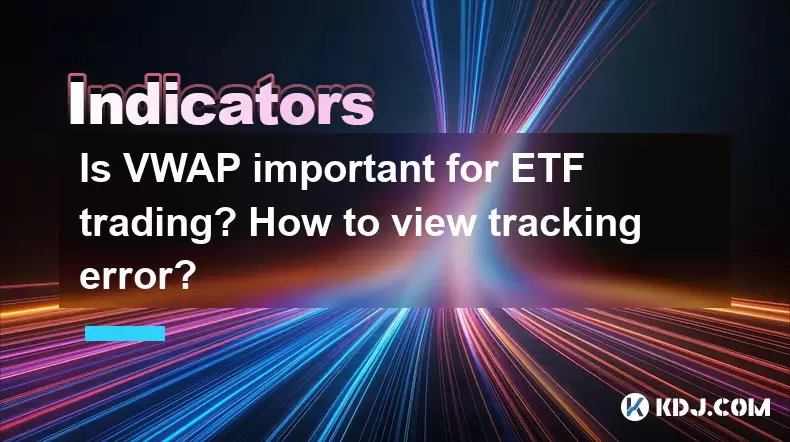-
 bitcoin
bitcoin $122090.672462 USD
1.59% -
 ethereum
ethereum $4493.758974 USD
0.56% -
 xrp
xrp $3.033145 USD
0.65% -
 tether
tether $1.000629 USD
0.00% -
 bnb
bnb $1169.854250 USD
7.07% -
 solana
solana $230.954786 USD
-0.19% -
 usd-coin
usd-coin $0.999785 USD
0.00% -
 dogecoin
dogecoin $0.256108 USD
-1.12% -
 tron
tron $0.342333 USD
-0.12% -
 cardano
cardano $0.859632 USD
-0.10% -
 hyperliquid
hyperliquid $48.932146 USD
-2.25% -
 chainlink
chainlink $22.345466 USD
-1.29% -
 ethena-usde
ethena-usde $1.000217 USD
-0.03% -
 avalanche
avalanche $31.203456 USD
1.93% -
 sui
sui $3.579145 USD
1.05%
Is VWAP important for ETF trading? How to view tracking error?
VWAP helps ETF traders gauge trade efficiency and market trends, while tracking error measures how closely an ETF follows its index, aiding informed investment decisions.
May 21, 2025 at 10:29 pm

Understanding VWAP in ETF Trading
Volume Weighted Average Price (VWAP) is a crucial metric in the trading world, particularly for Exchange-Traded Funds (ETFs). VWAP is calculated by taking the total dollar value of all trades in a specific security and dividing it by the total trading volume for that security over a given time period, usually one trading day. For ETF trading, VWAP serves as a benchmark to gauge the efficiency of trade execution. Traders often aim to execute their trades at a price that is better than the VWAP to ensure they are getting a favorable deal.
When trading ETFs, VWAP can help traders understand market trends and the average price at which the ETF has been trading throughout the day. This information can be vital for institutional investors who trade large volumes and need to minimize the market impact of their trades. By comparing their trade execution price to the VWAP, they can assess whether they are buying or selling at a premium or discount relative to the market average.
Importance of VWAP for ETF Investors
For ETF investors, VWAP is important because it provides a clear picture of the trading day's average price. This can be particularly useful for those who are looking to enter or exit positions in a way that minimizes slippage. Slippage refers to the difference between the expected price of a trade and the price at which the trade is actually executed. By using VWAP as a reference, investors can better time their trades to align with market averages, thereby reducing the potential for slippage.
Additionally, VWAP can be used to assess the performance of a trading strategy. If an investor consistently executes trades at prices better than the VWAP, it may indicate that their strategy is effective. Conversely, if trades are consistently executed at prices worse than the VWAP, it might be time to reevaluate the trading approach.
How to View Tracking Error in ETFs
Tracking error is a measure of how closely an ETF follows the index it is designed to replicate. It is calculated as the standard deviation of the difference between the returns of the ETF and the returns of the underlying index. A lower tracking error indicates that the ETF is closely tracking its benchmark index, while a higher tracking error suggests a larger deviation.
To view tracking error, investors can follow these steps:
- Identify the ETF and its benchmark index: Start by determining the specific ETF you are interested in and the index it tracks.
- Gather historical data: Obtain historical price data for both the ETF and its benchmark index over a specified period.
- Calculate the returns: Compute the daily or monthly returns for both the ETF and the index.
- Compute the difference in returns: Subtract the index returns from the ETF returns to get the daily or monthly differences.
- Calculate the standard deviation: Use the differences in returns to calculate the standard deviation, which is the tracking error.
Many financial websites and platforms provide tools to calculate and display tracking error, making it easier for investors to assess the performance of their ETFs.
Using VWAP and Tracking Error Together
Combining VWAP and tracking error can provide a more comprehensive view of an ETF's performance. While VWAP helps traders understand the average price at which the ETF is trading, tracking error provides insight into how well the ETF is replicating its benchmark index. Together, these metrics can help investors make more informed decisions about their trading and investment strategies.
For example, if an ETF has a low tracking error but consistently trades at prices worse than the VWAP, it may indicate that the ETF is closely following its index but at a higher cost to investors. Conversely, an ETF with a high tracking error but trades at prices better than the VWAP might suggest that while the ETF deviates from its index, it is doing so in a way that benefits investors.
Practical Application of VWAP in ETF Trading
To effectively use VWAP in ETF trading, investors should consider the following practical steps:
- Monitor VWAP in real-time: Use trading platforms that provide real-time VWAP data to make timely trading decisions.
- Compare execution prices to VWAP: After executing a trade, compare the execution price to the VWAP to assess the efficiency of the trade.
- Use VWAP for intraday trading: For those engaged in intraday trading, VWAP can serve as a key indicator for entry and exit points.
- Integrate VWAP into trading algorithms: For algorithmic traders, incorporating VWAP into trading algorithms can help automate the process of achieving better trade execution.
By following these steps, traders can leverage VWAP to enhance their ETF trading strategies and improve overall trading performance.
Frequently Asked Questions
Q1: Can VWAP be used for long-term investment strategies in ETFs?While VWAP is primarily used for intraday trading and assessing trade execution, it can also be useful for long-term investors. By analyzing the VWAP over longer periods, investors can gain insights into the average price trends of an ETF, which can inform their buy and sell decisions.
Q2: How often should tracking error be monitored for an ETF?Tracking error should be monitored regularly, ideally on a monthly basis. This frequency allows investors to stay updated on the ETF's performance relative to its benchmark index and make adjustments to their investment strategy if necessary.
Q3: Are there any tools or platforms that can automatically calculate VWAP and tracking error for ETFs?Yes, several financial platforms and trading software offer tools that automatically calculate VWAP and tracking error for ETFs. Examples include Bloomberg Terminal, TradingView, and various brokerage platforms that provide advanced analytics for investors.
Q4: Can tracking error be negative, and what does it signify?Tracking error is typically reported as a positive number, representing the standard deviation of the difference in returns. However, if an ETF consistently outperforms its benchmark index, the average difference in returns could be negative, indicating that the ETF is doing better than the index. This does not mean the tracking error itself is negative but rather that the ETF is generating higher returns than the index on average.
Disclaimer:info@kdj.com
The information provided is not trading advice. kdj.com does not assume any responsibility for any investments made based on the information provided in this article. Cryptocurrencies are highly volatile and it is highly recommended that you invest with caution after thorough research!
If you believe that the content used on this website infringes your copyright, please contact us immediately (info@kdj.com) and we will delete it promptly.
- BlockDAG, DOGE, HYPE Sponsorship: Crypto Trends Shaping 2025
- 2025-10-01 00:25:13
- Deutsche Börse and Circle: A StableCoin Adoption Powerhouse in Europe
- 2025-10-01 00:25:13
- BlockDAG's Presale Buzz: Is It the Crypto to Watch in October 2025?
- 2025-10-01 00:30:13
- Bitcoin, Crypto, and IQ: When Genius Meets Digital Gold?
- 2025-10-01 00:30:13
- Stablecoins, American Innovation, and Wallet Tokens: The Next Frontier
- 2025-10-01 00:35:12
- NBU, Coins, and Crypto in Ukraine: A New Yorker's Take
- 2025-10-01 00:45:14
Related knowledge

What is a tower bottom candlestick pattern? Does it have a high success rate?
Sep 22,2025 at 07:18am
Tower Bottom Candlestick Pattern Explained1. The tower bottom candlestick pattern is a reversal formation that typically appears at the end of a downt...

What is a black hole pattern in the MACD indicator? Is it a cause for concern?
Sep 21,2025 at 06:54pm
Bitcoin's Role in Decentralized Finance1. Bitcoin remains the cornerstone of decentralized finance, serving as a benchmark for value and security acro...

How can I use the psychological line (PSY) to determine market sentiment?
Sep 17,2025 at 02:19pm
Understanding the Psychological Line (PSY) in Cryptocurrency TradingThe Psychological Line, commonly referred to as PSY, is a momentum oscillator used...

How can I determine if a double top pattern has officially formed?
Sep 21,2025 at 03:18am
Understanding the Structure of a Double Top Pattern1. A double top pattern consists of two distinct peaks that reach approximately the same price leve...

What is the Golden Valley pattern on the moving average? Is it better than the Silver Valley pattern?
Sep 21,2025 at 02:54pm
Understanding the Golden Valley Pattern in Moving Averages1. The Golden Valley pattern is a technical formation observed in cryptocurrency price chart...

What does a death cross of the RSI in the strong zone (above 50) mean?
Sep 17,2025 at 10:54pm
Understanding the Death Cross in RSI Context1. The term 'death cross' is traditionally associated with moving averages, where a short-term average cro...

What is a tower bottom candlestick pattern? Does it have a high success rate?
Sep 22,2025 at 07:18am
Tower Bottom Candlestick Pattern Explained1. The tower bottom candlestick pattern is a reversal formation that typically appears at the end of a downt...

What is a black hole pattern in the MACD indicator? Is it a cause for concern?
Sep 21,2025 at 06:54pm
Bitcoin's Role in Decentralized Finance1. Bitcoin remains the cornerstone of decentralized finance, serving as a benchmark for value and security acro...

How can I use the psychological line (PSY) to determine market sentiment?
Sep 17,2025 at 02:19pm
Understanding the Psychological Line (PSY) in Cryptocurrency TradingThe Psychological Line, commonly referred to as PSY, is a momentum oscillator used...

How can I determine if a double top pattern has officially formed?
Sep 21,2025 at 03:18am
Understanding the Structure of a Double Top Pattern1. A double top pattern consists of two distinct peaks that reach approximately the same price leve...

What is the Golden Valley pattern on the moving average? Is it better than the Silver Valley pattern?
Sep 21,2025 at 02:54pm
Understanding the Golden Valley Pattern in Moving Averages1. The Golden Valley pattern is a technical formation observed in cryptocurrency price chart...

What does a death cross of the RSI in the strong zone (above 50) mean?
Sep 17,2025 at 10:54pm
Understanding the Death Cross in RSI Context1. The term 'death cross' is traditionally associated with moving averages, where a short-term average cro...
See all articles










































































